Coursework: Counselling for Grief and Loss Theories Analysis
VerifiedAdded on 2022/10/14
|10
|2747
|53
Essay
AI Summary
This essay critically analyzes contemporary theories of grief and loss counselling. The introduction defines grief and its various forms, including bereavement, and highlights the importance of professional help, such as grief counseling, which utilizes psychotherapy to assist individuals in managing and overcoming loss. The essay focuses on two key theories: the dual-process model of coping with bereavement by Stroebe and Schut, and Rubin's two-track model of bereavement. The dual-process model is discussed in detail, explaining the loss and restoration orientations and their impact on the grieving process, drawing on personal experience. The essay explores the advantages of the dual-process model, such as its effectiveness in transforming grief into positive emotions, while also acknowledging its limitations, such as the potential for overwhelming negative feelings. Rubin's two-track model is examined, focusing on the biopsychological and relationship tracks, and how they provide a framework for understanding and addressing the multifaceted aspects of grief. The strengths of the two-track model are highlighted, particularly its ability to facilitate the release of negative emotions and monitor the individual's health. The essay concludes by summarizing the different approaches and activities offered by grief theories, emphasizing the influence of personal attributes on the application of these theories and the importance of empathy and care during the grieving process.
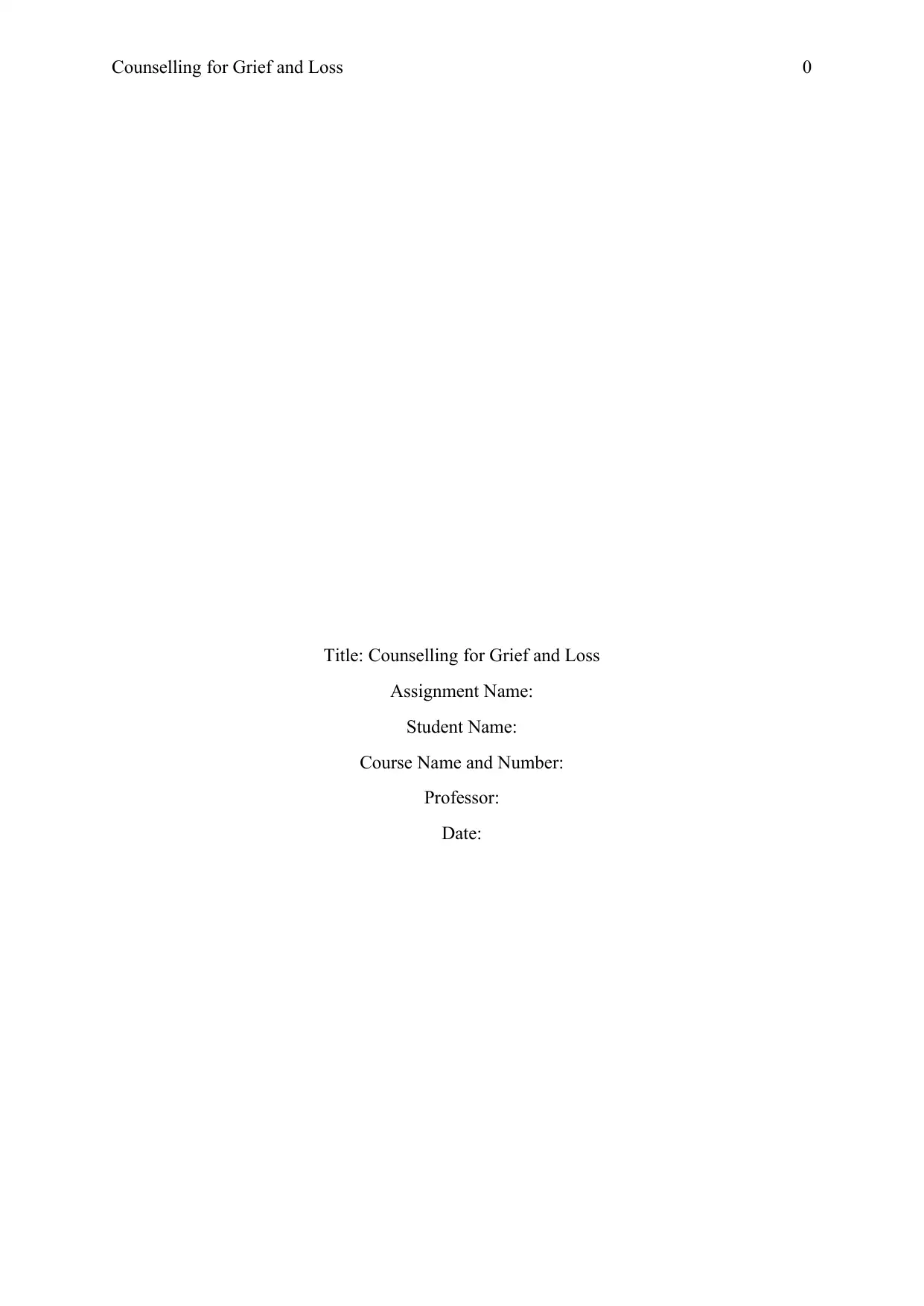
Counselling for Grief and Loss 0
Title: Counselling for Grief and Loss
Assignment Name:
Student Name:
Course Name and Number:
Professor:
Date:
Title: Counselling for Grief and Loss
Assignment Name:
Student Name:
Course Name and Number:
Professor:
Date:
Paraphrase This Document
Need a fresh take? Get an instant paraphrase of this document with our AI Paraphraser

Counselling for Grief and Loss 1
Contents
Introduction................................................................................................................................2
Critical Analysis of Contemporary Theories of Grief and Loss................................................2
Conclusion..................................................................................................................................6
References..................................................................................................................................8
Contents
Introduction................................................................................................................................2
Critical Analysis of Contemporary Theories of Grief and Loss................................................2
Conclusion..................................................................................................................................6
References..................................................................................................................................8
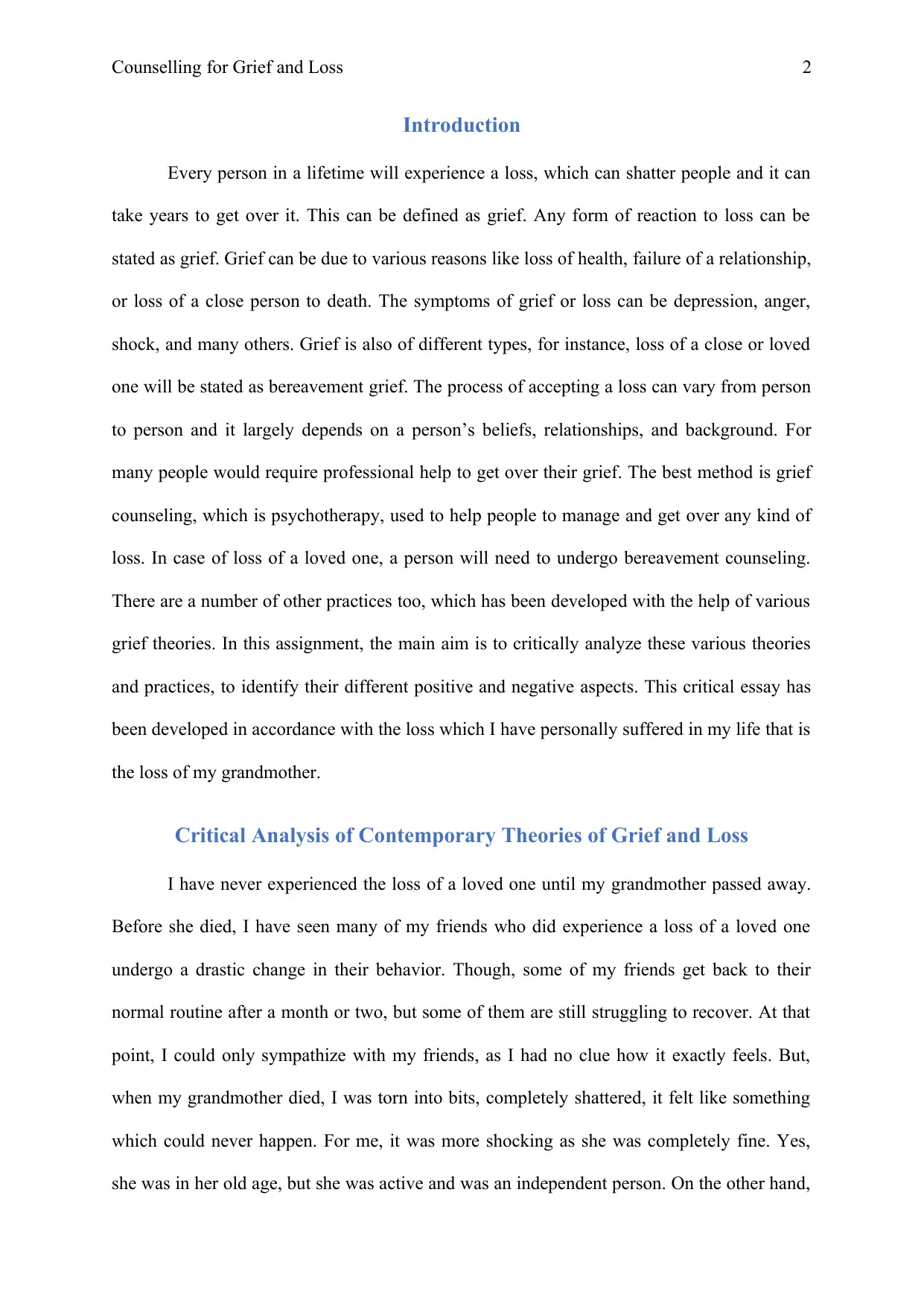
Counselling for Grief and Loss 2
Introduction
Every person in a lifetime will experience a loss, which can shatter people and it can
take years to get over it. This can be defined as grief. Any form of reaction to loss can be
stated as grief. Grief can be due to various reasons like loss of health, failure of a relationship,
or loss of a close person to death. The symptoms of grief or loss can be depression, anger,
shock, and many others. Grief is also of different types, for instance, loss of a close or loved
one will be stated as bereavement grief. The process of accepting a loss can vary from person
to person and it largely depends on a person’s beliefs, relationships, and background. For
many people would require professional help to get over their grief. The best method is grief
counseling, which is psychotherapy, used to help people to manage and get over any kind of
loss. In case of loss of a loved one, a person will need to undergo bereavement counseling.
There are a number of other practices too, which has been developed with the help of various
grief theories. In this assignment, the main aim is to critically analyze these various theories
and practices, to identify their different positive and negative aspects. This critical essay has
been developed in accordance with the loss which I have personally suffered in my life that is
the loss of my grandmother.
Critical Analysis of Contemporary Theories of Grief and Loss
I have never experienced the loss of a loved one until my grandmother passed away.
Before she died, I have seen many of my friends who did experience a loss of a loved one
undergo a drastic change in their behavior. Though, some of my friends get back to their
normal routine after a month or two, but some of them are still struggling to recover. At that
point, I could only sympathize with my friends, as I had no clue how it exactly feels. But,
when my grandmother died, I was torn into bits, completely shattered, it felt like something
which could never happen. For me, it was more shocking as she was completely fine. Yes,
she was in her old age, but she was active and was an independent person. On the other hand,
Introduction
Every person in a lifetime will experience a loss, which can shatter people and it can
take years to get over it. This can be defined as grief. Any form of reaction to loss can be
stated as grief. Grief can be due to various reasons like loss of health, failure of a relationship,
or loss of a close person to death. The symptoms of grief or loss can be depression, anger,
shock, and many others. Grief is also of different types, for instance, loss of a close or loved
one will be stated as bereavement grief. The process of accepting a loss can vary from person
to person and it largely depends on a person’s beliefs, relationships, and background. For
many people would require professional help to get over their grief. The best method is grief
counseling, which is psychotherapy, used to help people to manage and get over any kind of
loss. In case of loss of a loved one, a person will need to undergo bereavement counseling.
There are a number of other practices too, which has been developed with the help of various
grief theories. In this assignment, the main aim is to critically analyze these various theories
and practices, to identify their different positive and negative aspects. This critical essay has
been developed in accordance with the loss which I have personally suffered in my life that is
the loss of my grandmother.
Critical Analysis of Contemporary Theories of Grief and Loss
I have never experienced the loss of a loved one until my grandmother passed away.
Before she died, I have seen many of my friends who did experience a loss of a loved one
undergo a drastic change in their behavior. Though, some of my friends get back to their
normal routine after a month or two, but some of them are still struggling to recover. At that
point, I could only sympathize with my friends, as I had no clue how it exactly feels. But,
when my grandmother died, I was torn into bits, completely shattered, it felt like something
which could never happen. For me, it was more shocking as she was completely fine. Yes,
she was in her old age, but she was active and was an independent person. On the other hand,
⊘ This is a preview!⊘
Do you want full access?
Subscribe today to unlock all pages.

Trusted by 1+ million students worldwide
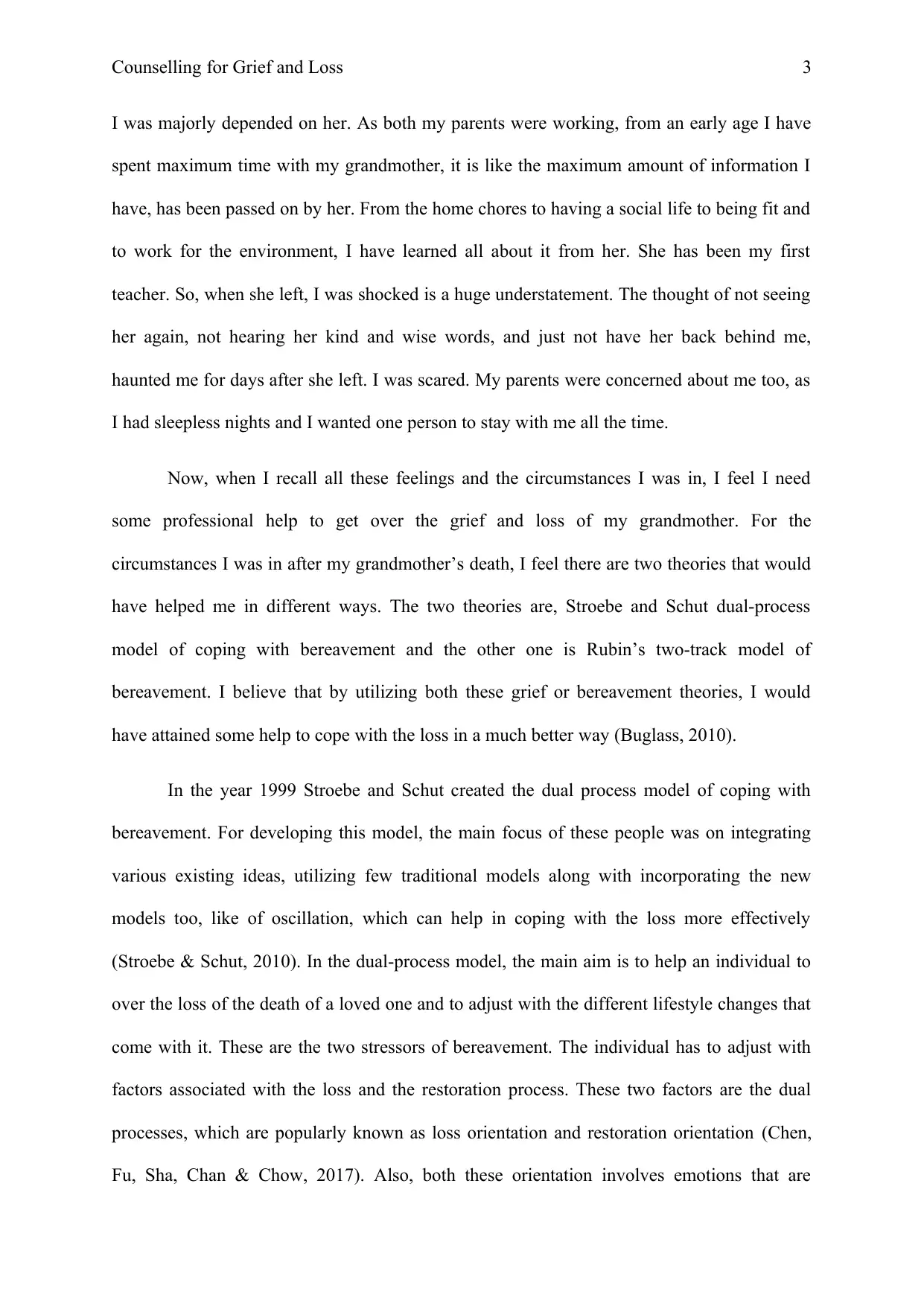
Counselling for Grief and Loss 3
I was majorly depended on her. As both my parents were working, from an early age I have
spent maximum time with my grandmother, it is like the maximum amount of information I
have, has been passed on by her. From the home chores to having a social life to being fit and
to work for the environment, I have learned all about it from her. She has been my first
teacher. So, when she left, I was shocked is a huge understatement. The thought of not seeing
her again, not hearing her kind and wise words, and just not have her back behind me,
haunted me for days after she left. I was scared. My parents were concerned about me too, as
I had sleepless nights and I wanted one person to stay with me all the time.
Now, when I recall all these feelings and the circumstances I was in, I feel I need
some professional help to get over the grief and loss of my grandmother. For the
circumstances I was in after my grandmother’s death, I feel there are two theories that would
have helped me in different ways. The two theories are, Stroebe and Schut dual-process
model of coping with bereavement and the other one is Rubin’s two-track model of
bereavement. I believe that by utilizing both these grief or bereavement theories, I would
have attained some help to cope with the loss in a much better way (Buglass, 2010).
In the year 1999 Stroebe and Schut created the dual process model of coping with
bereavement. For developing this model, the main focus of these people was on integrating
various existing ideas, utilizing few traditional models along with incorporating the new
models too, like of oscillation, which can help in coping with the loss more effectively
(Stroebe & Schut, 2010). In the dual-process model, the main aim is to help an individual to
over the loss of the death of a loved one and to adjust with the different lifestyle changes that
come with it. These are the two stressors of bereavement. The individual has to adjust with
factors associated with the loss and the restoration process. These two factors are the dual
processes, which are popularly known as loss orientation and restoration orientation (Chen,
Fu, Sha, Chan & Chow, 2017). Also, both these orientation involves emotions that are
I was majorly depended on her. As both my parents were working, from an early age I have
spent maximum time with my grandmother, it is like the maximum amount of information I
have, has been passed on by her. From the home chores to having a social life to being fit and
to work for the environment, I have learned all about it from her. She has been my first
teacher. So, when she left, I was shocked is a huge understatement. The thought of not seeing
her again, not hearing her kind and wise words, and just not have her back behind me,
haunted me for days after she left. I was scared. My parents were concerned about me too, as
I had sleepless nights and I wanted one person to stay with me all the time.
Now, when I recall all these feelings and the circumstances I was in, I feel I need
some professional help to get over the grief and loss of my grandmother. For the
circumstances I was in after my grandmother’s death, I feel there are two theories that would
have helped me in different ways. The two theories are, Stroebe and Schut dual-process
model of coping with bereavement and the other one is Rubin’s two-track model of
bereavement. I believe that by utilizing both these grief or bereavement theories, I would
have attained some help to cope with the loss in a much better way (Buglass, 2010).
In the year 1999 Stroebe and Schut created the dual process model of coping with
bereavement. For developing this model, the main focus of these people was on integrating
various existing ideas, utilizing few traditional models along with incorporating the new
models too, like of oscillation, which can help in coping with the loss more effectively
(Stroebe & Schut, 2010). In the dual-process model, the main aim is to help an individual to
over the loss of the death of a loved one and to adjust with the different lifestyle changes that
come with it. These are the two stressors of bereavement. The individual has to adjust with
factors associated with the loss and the restoration process. These two factors are the dual
processes, which are popularly known as loss orientation and restoration orientation (Chen,
Fu, Sha, Chan & Chow, 2017). Also, both these orientation involves emotions that are
Paraphrase This Document
Need a fresh take? Get an instant paraphrase of this document with our AI Paraphraser
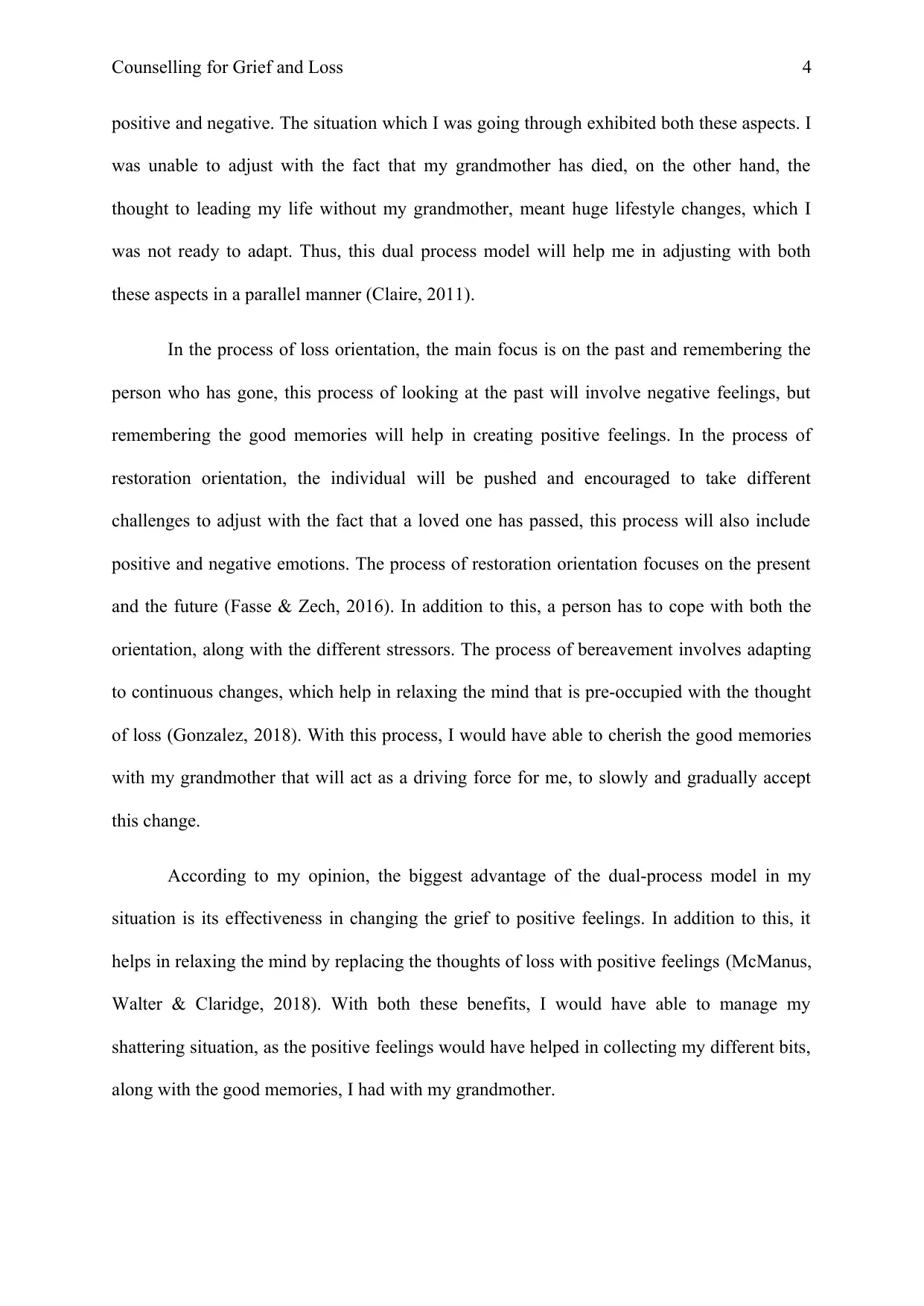
Counselling for Grief and Loss 4
positive and negative. The situation which I was going through exhibited both these aspects. I
was unable to adjust with the fact that my grandmother has died, on the other hand, the
thought to leading my life without my grandmother, meant huge lifestyle changes, which I
was not ready to adapt. Thus, this dual process model will help me in adjusting with both
these aspects in a parallel manner (Claire, 2011).
In the process of loss orientation, the main focus is on the past and remembering the
person who has gone, this process of looking at the past will involve negative feelings, but
remembering the good memories will help in creating positive feelings. In the process of
restoration orientation, the individual will be pushed and encouraged to take different
challenges to adjust with the fact that a loved one has passed, this process will also include
positive and negative emotions. The process of restoration orientation focuses on the present
and the future (Fasse & Zech, 2016). In addition to this, a person has to cope with both the
orientation, along with the different stressors. The process of bereavement involves adapting
to continuous changes, which help in relaxing the mind that is pre-occupied with the thought
of loss (Gonzalez, 2018). With this process, I would have able to cherish the good memories
with my grandmother that will act as a driving force for me, to slowly and gradually accept
this change.
According to my opinion, the biggest advantage of the dual-process model in my
situation is its effectiveness in changing the grief to positive feelings. In addition to this, it
helps in relaxing the mind by replacing the thoughts of loss with positive feelings (McManus,
Walter & Claridge, 2018). With both these benefits, I would have able to manage my
shattering situation, as the positive feelings would have helped in collecting my different bits,
along with the good memories, I had with my grandmother.
positive and negative. The situation which I was going through exhibited both these aspects. I
was unable to adjust with the fact that my grandmother has died, on the other hand, the
thought to leading my life without my grandmother, meant huge lifestyle changes, which I
was not ready to adapt. Thus, this dual process model will help me in adjusting with both
these aspects in a parallel manner (Claire, 2011).
In the process of loss orientation, the main focus is on the past and remembering the
person who has gone, this process of looking at the past will involve negative feelings, but
remembering the good memories will help in creating positive feelings. In the process of
restoration orientation, the individual will be pushed and encouraged to take different
challenges to adjust with the fact that a loved one has passed, this process will also include
positive and negative emotions. The process of restoration orientation focuses on the present
and the future (Fasse & Zech, 2016). In addition to this, a person has to cope with both the
orientation, along with the different stressors. The process of bereavement involves adapting
to continuous changes, which help in relaxing the mind that is pre-occupied with the thought
of loss (Gonzalez, 2018). With this process, I would have able to cherish the good memories
with my grandmother that will act as a driving force for me, to slowly and gradually accept
this change.
According to my opinion, the biggest advantage of the dual-process model in my
situation is its effectiveness in changing the grief to positive feelings. In addition to this, it
helps in relaxing the mind by replacing the thoughts of loss with positive feelings (McManus,
Walter & Claridge, 2018). With both these benefits, I would have able to manage my
shattering situation, as the positive feelings would have helped in collecting my different bits,
along with the good memories, I had with my grandmother.
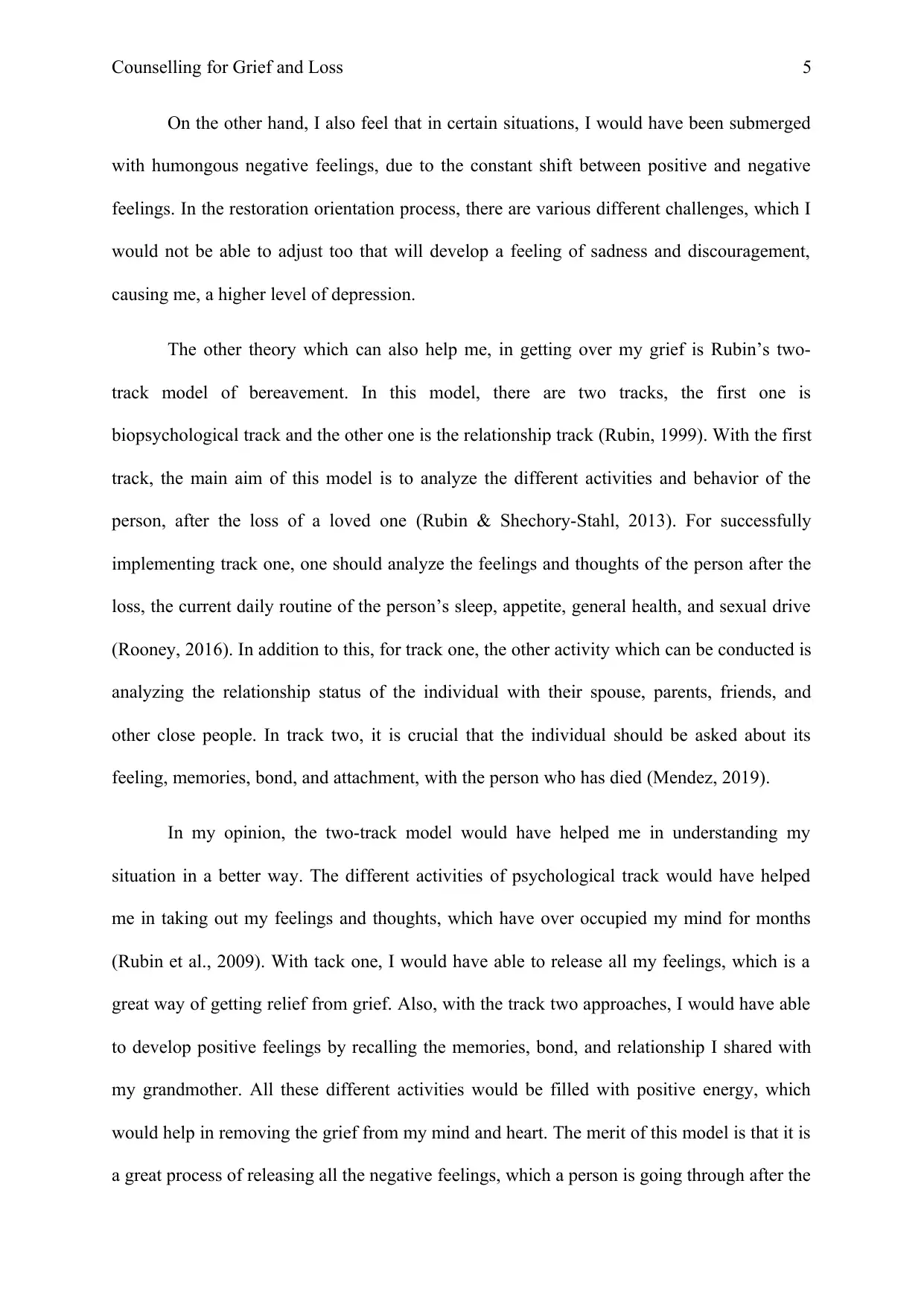
Counselling for Grief and Loss 5
On the other hand, I also feel that in certain situations, I would have been submerged
with humongous negative feelings, due to the constant shift between positive and negative
feelings. In the restoration orientation process, there are various different challenges, which I
would not be able to adjust too that will develop a feeling of sadness and discouragement,
causing me, a higher level of depression.
The other theory which can also help me, in getting over my grief is Rubin’s two-
track model of bereavement. In this model, there are two tracks, the first one is
biopsychological track and the other one is the relationship track (Rubin, 1999). With the first
track, the main aim of this model is to analyze the different activities and behavior of the
person, after the loss of a loved one (Rubin & Shechory-Stahl, 2013). For successfully
implementing track one, one should analyze the feelings and thoughts of the person after the
loss, the current daily routine of the person’s sleep, appetite, general health, and sexual drive
(Rooney, 2016). In addition to this, for track one, the other activity which can be conducted is
analyzing the relationship status of the individual with their spouse, parents, friends, and
other close people. In track two, it is crucial that the individual should be asked about its
feeling, memories, bond, and attachment, with the person who has died (Mendez, 2019).
In my opinion, the two-track model would have helped me in understanding my
situation in a better way. The different activities of psychological track would have helped
me in taking out my feelings and thoughts, which have over occupied my mind for months
(Rubin et al., 2009). With tack one, I would have able to release all my feelings, which is a
great way of getting relief from grief. Also, with the track two approaches, I would have able
to develop positive feelings by recalling the memories, bond, and relationship I shared with
my grandmother. All these different activities would be filled with positive energy, which
would help in removing the grief from my mind and heart. The merit of this model is that it is
a great process of releasing all the negative feelings, which a person is going through after the
On the other hand, I also feel that in certain situations, I would have been submerged
with humongous negative feelings, due to the constant shift between positive and negative
feelings. In the restoration orientation process, there are various different challenges, which I
would not be able to adjust too that will develop a feeling of sadness and discouragement,
causing me, a higher level of depression.
The other theory which can also help me, in getting over my grief is Rubin’s two-
track model of bereavement. In this model, there are two tracks, the first one is
biopsychological track and the other one is the relationship track (Rubin, 1999). With the first
track, the main aim of this model is to analyze the different activities and behavior of the
person, after the loss of a loved one (Rubin & Shechory-Stahl, 2013). For successfully
implementing track one, one should analyze the feelings and thoughts of the person after the
loss, the current daily routine of the person’s sleep, appetite, general health, and sexual drive
(Rooney, 2016). In addition to this, for track one, the other activity which can be conducted is
analyzing the relationship status of the individual with their spouse, parents, friends, and
other close people. In track two, it is crucial that the individual should be asked about its
feeling, memories, bond, and attachment, with the person who has died (Mendez, 2019).
In my opinion, the two-track model would have helped me in understanding my
situation in a better way. The different activities of psychological track would have helped
me in taking out my feelings and thoughts, which have over occupied my mind for months
(Rubin et al., 2009). With tack one, I would have able to release all my feelings, which is a
great way of getting relief from grief. Also, with the track two approaches, I would have able
to develop positive feelings by recalling the memories, bond, and relationship I shared with
my grandmother. All these different activities would be filled with positive energy, which
would help in removing the grief from my mind and heart. The merit of this model is that it is
a great process of releasing all the negative feelings, which a person is going through after the
⊘ This is a preview!⊘
Do you want full access?
Subscribe today to unlock all pages.

Trusted by 1+ million students worldwide
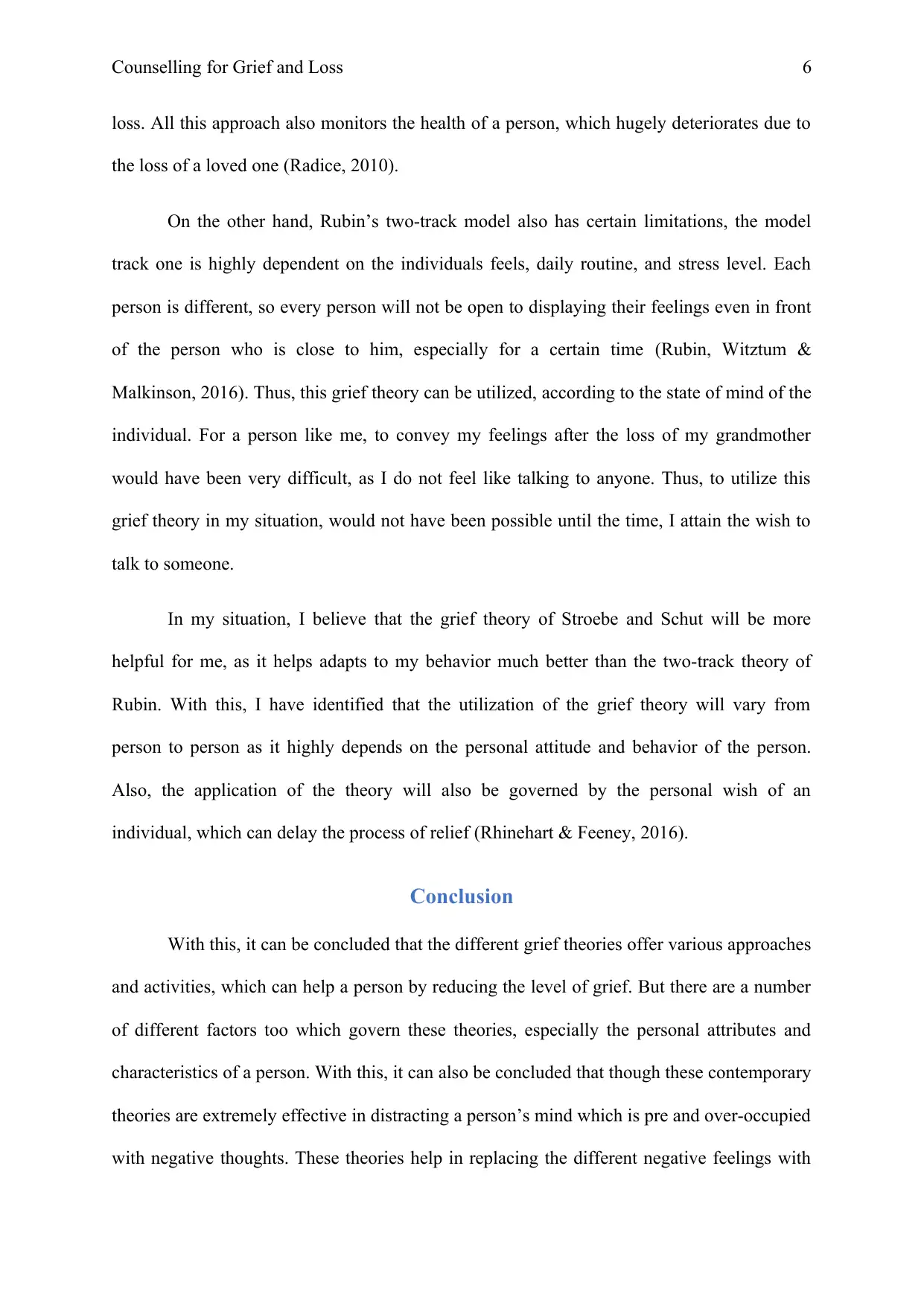
Counselling for Grief and Loss 6
loss. All this approach also monitors the health of a person, which hugely deteriorates due to
the loss of a loved one (Radice, 2010).
On the other hand, Rubin’s two-track model also has certain limitations, the model
track one is highly dependent on the individuals feels, daily routine, and stress level. Each
person is different, so every person will not be open to displaying their feelings even in front
of the person who is close to him, especially for a certain time (Rubin, Witztum &
Malkinson, 2016). Thus, this grief theory can be utilized, according to the state of mind of the
individual. For a person like me, to convey my feelings after the loss of my grandmother
would have been very difficult, as I do not feel like talking to anyone. Thus, to utilize this
grief theory in my situation, would not have been possible until the time, I attain the wish to
talk to someone.
In my situation, I believe that the grief theory of Stroebe and Schut will be more
helpful for me, as it helps adapts to my behavior much better than the two-track theory of
Rubin. With this, I have identified that the utilization of the grief theory will vary from
person to person as it highly depends on the personal attitude and behavior of the person.
Also, the application of the theory will also be governed by the personal wish of an
individual, which can delay the process of relief (Rhinehart & Feeney, 2016).
Conclusion
With this, it can be concluded that the different grief theories offer various approaches
and activities, which can help a person by reducing the level of grief. But there are a number
of different factors too which govern these theories, especially the personal attributes and
characteristics of a person. With this, it can also be concluded that though these contemporary
theories are extremely effective in distracting a person’s mind which is pre and over-occupied
with negative thoughts. These theories help in replacing the different negative feelings with
loss. All this approach also monitors the health of a person, which hugely deteriorates due to
the loss of a loved one (Radice, 2010).
On the other hand, Rubin’s two-track model also has certain limitations, the model
track one is highly dependent on the individuals feels, daily routine, and stress level. Each
person is different, so every person will not be open to displaying their feelings even in front
of the person who is close to him, especially for a certain time (Rubin, Witztum &
Malkinson, 2016). Thus, this grief theory can be utilized, according to the state of mind of the
individual. For a person like me, to convey my feelings after the loss of my grandmother
would have been very difficult, as I do not feel like talking to anyone. Thus, to utilize this
grief theory in my situation, would not have been possible until the time, I attain the wish to
talk to someone.
In my situation, I believe that the grief theory of Stroebe and Schut will be more
helpful for me, as it helps adapts to my behavior much better than the two-track theory of
Rubin. With this, I have identified that the utilization of the grief theory will vary from
person to person as it highly depends on the personal attitude and behavior of the person.
Also, the application of the theory will also be governed by the personal wish of an
individual, which can delay the process of relief (Rhinehart & Feeney, 2016).
Conclusion
With this, it can be concluded that the different grief theories offer various approaches
and activities, which can help a person by reducing the level of grief. But there are a number
of different factors too which govern these theories, especially the personal attributes and
characteristics of a person. With this, it can also be concluded that though these contemporary
theories are extremely effective in distracting a person’s mind which is pre and over-occupied
with negative thoughts. These theories help in replacing the different negative feelings with
Paraphrase This Document
Need a fresh take? Get an instant paraphrase of this document with our AI Paraphraser

Counselling for Grief and Loss 7
positive feelings that develop by constantly remembering and cherishing, the different good
memories a person had with the loved one, who has passed away. In the process of
application of the grief theory, it is also crucial that when a person is filled with negative
theories, then the individual should be handled with care and love.
positive feelings that develop by constantly remembering and cherishing, the different good
memories a person had with the loved one, who has passed away. In the process of
application of the grief theory, it is also crucial that when a person is filled with negative
theories, then the individual should be handled with care and love.
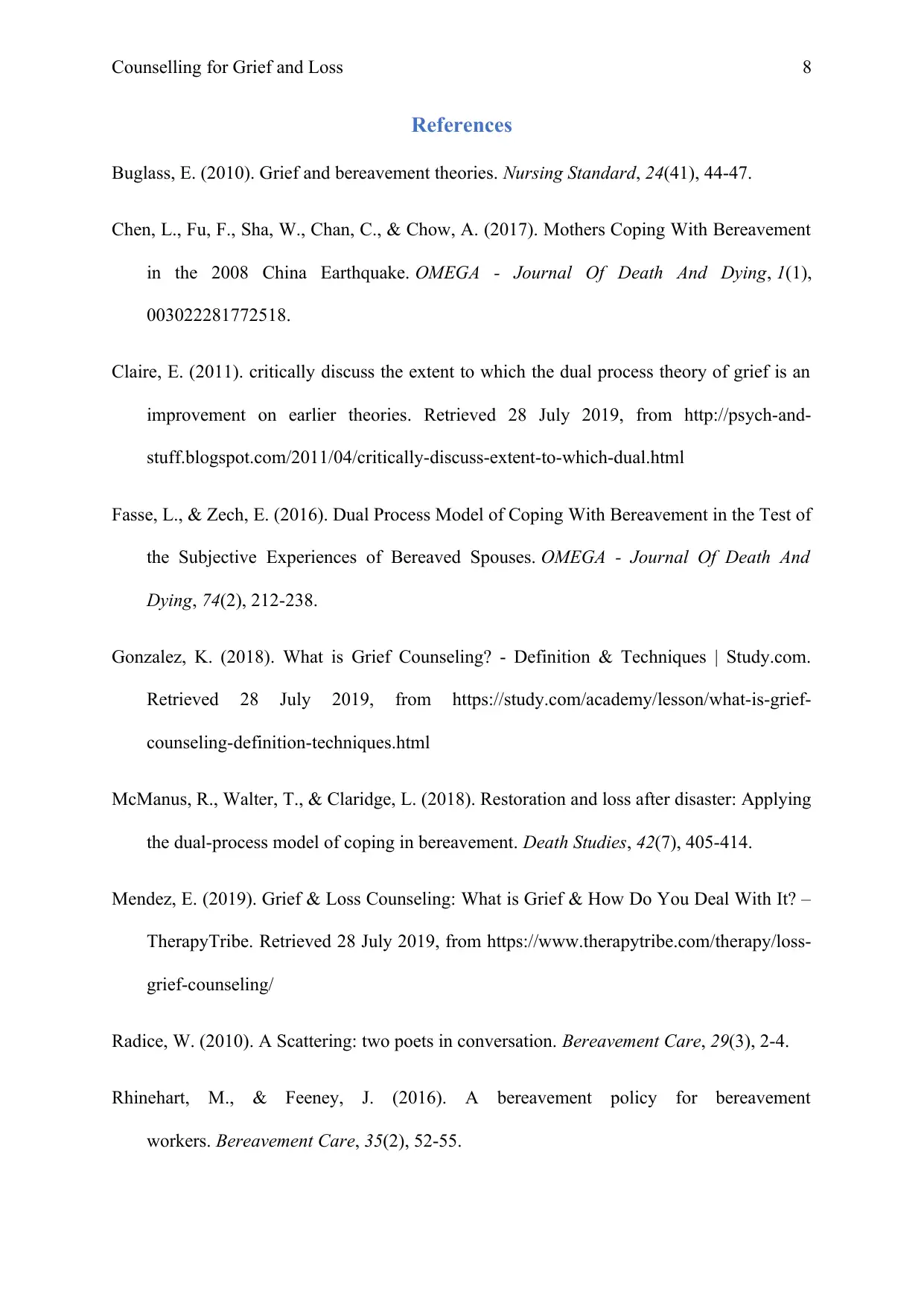
Counselling for Grief and Loss 8
References
Buglass, E. (2010). Grief and bereavement theories. Nursing Standard, 24(41), 44-47.
Chen, L., Fu, F., Sha, W., Chan, C., & Chow, A. (2017). Mothers Coping With Bereavement
in the 2008 China Earthquake. OMEGA - Journal Of Death And Dying, 1(1),
003022281772518.
Claire, E. (2011). critically discuss the extent to which the dual process theory of grief is an
improvement on earlier theories. Retrieved 28 July 2019, from http://psych-and-
stuff.blogspot.com/2011/04/critically-discuss-extent-to-which-dual.html
Fasse, L., & Zech, E. (2016). Dual Process Model of Coping With Bereavement in the Test of
the Subjective Experiences of Bereaved Spouses. OMEGA - Journal Of Death And
Dying, 74(2), 212-238.
Gonzalez, K. (2018). What is Grief Counseling? - Definition & Techniques | Study.com.
Retrieved 28 July 2019, from https://study.com/academy/lesson/what-is-grief-
counseling-definition-techniques.html
McManus, R., Walter, T., & Claridge, L. (2018). Restoration and loss after disaster: Applying
the dual-process model of coping in bereavement. Death Studies, 42(7), 405-414.
Mendez, E. (2019). Grief & Loss Counseling: What is Grief & How Do You Deal With It? –
TherapyTribe. Retrieved 28 July 2019, from https://www.therapytribe.com/therapy/loss-
grief-counseling/
Radice, W. (2010). A Scattering: two poets in conversation. Bereavement Care, 29(3), 2-4.
Rhinehart, M., & Feeney, J. (2016). A bereavement policy for bereavement
workers. Bereavement Care, 35(2), 52-55.
References
Buglass, E. (2010). Grief and bereavement theories. Nursing Standard, 24(41), 44-47.
Chen, L., Fu, F., Sha, W., Chan, C., & Chow, A. (2017). Mothers Coping With Bereavement
in the 2008 China Earthquake. OMEGA - Journal Of Death And Dying, 1(1),
003022281772518.
Claire, E. (2011). critically discuss the extent to which the dual process theory of grief is an
improvement on earlier theories. Retrieved 28 July 2019, from http://psych-and-
stuff.blogspot.com/2011/04/critically-discuss-extent-to-which-dual.html
Fasse, L., & Zech, E. (2016). Dual Process Model of Coping With Bereavement in the Test of
the Subjective Experiences of Bereaved Spouses. OMEGA - Journal Of Death And
Dying, 74(2), 212-238.
Gonzalez, K. (2018). What is Grief Counseling? - Definition & Techniques | Study.com.
Retrieved 28 July 2019, from https://study.com/academy/lesson/what-is-grief-
counseling-definition-techniques.html
McManus, R., Walter, T., & Claridge, L. (2018). Restoration and loss after disaster: Applying
the dual-process model of coping in bereavement. Death Studies, 42(7), 405-414.
Mendez, E. (2019). Grief & Loss Counseling: What is Grief & How Do You Deal With It? –
TherapyTribe. Retrieved 28 July 2019, from https://www.therapytribe.com/therapy/loss-
grief-counseling/
Radice, W. (2010). A Scattering: two poets in conversation. Bereavement Care, 29(3), 2-4.
Rhinehart, M., & Feeney, J. (2016). A bereavement policy for bereavement
workers. Bereavement Care, 35(2), 52-55.
⊘ This is a preview!⊘
Do you want full access?
Subscribe today to unlock all pages.

Trusted by 1+ million students worldwide
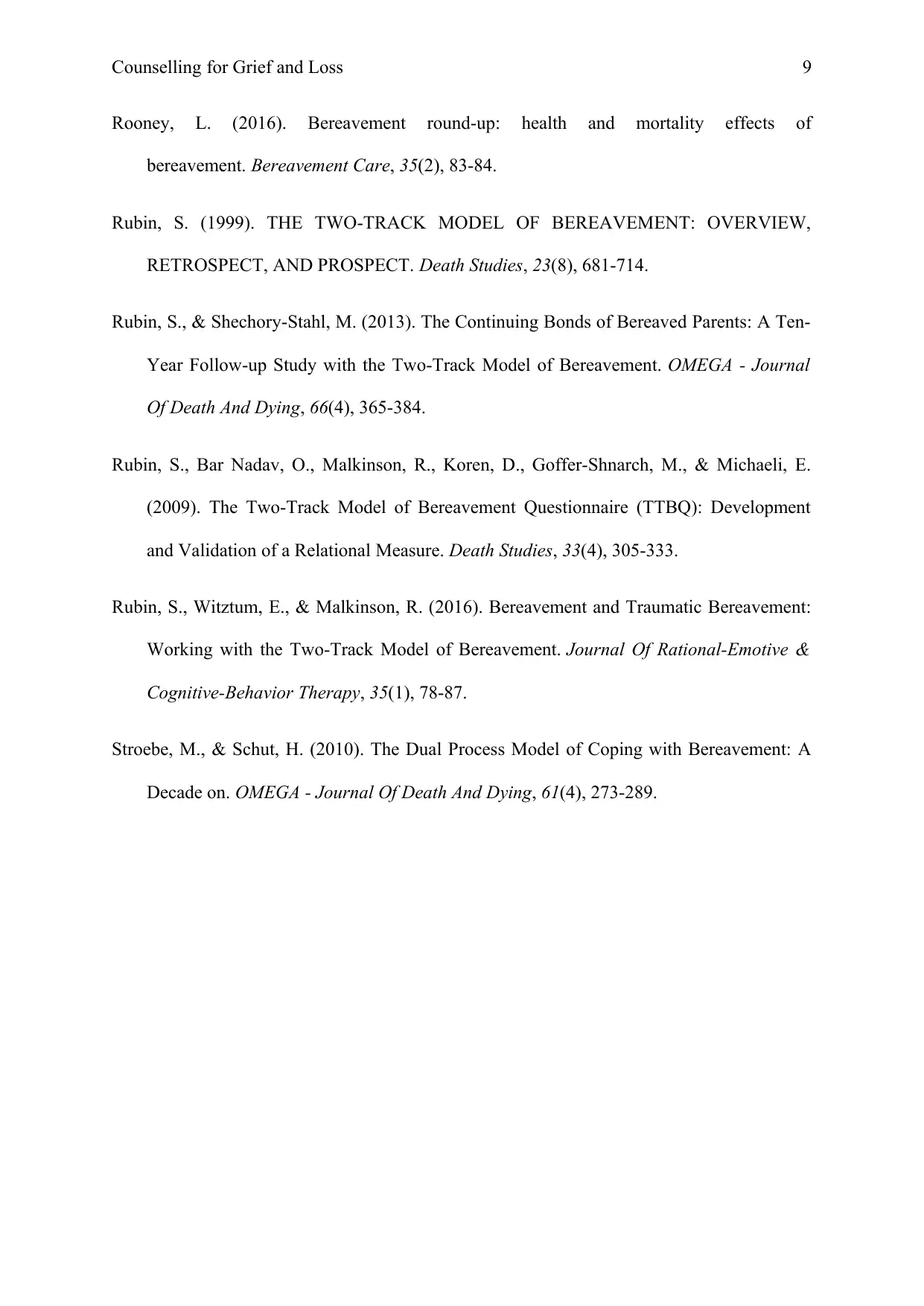
Counselling for Grief and Loss 9
Rooney, L. (2016). Bereavement round-up: health and mortality effects of
bereavement. Bereavement Care, 35(2), 83-84.
Rubin, S. (1999). THE TWO-TRACK MODEL OF BEREAVEMENT: OVERVIEW,
RETROSPECT, AND PROSPECT. Death Studies, 23(8), 681-714.
Rubin, S., & Shechory-Stahl, M. (2013). The Continuing Bonds of Bereaved Parents: A Ten-
Year Follow-up Study with the Two-Track Model of Bereavement. OMEGA - Journal
Of Death And Dying, 66(4), 365-384.
Rubin, S., Bar Nadav, O., Malkinson, R., Koren, D., Goffer-Shnarch, M., & Michaeli, E.
(2009). The Two-Track Model of Bereavement Questionnaire (TTBQ): Development
and Validation of a Relational Measure. Death Studies, 33(4), 305-333.
Rubin, S., Witztum, E., & Malkinson, R. (2016). Bereavement and Traumatic Bereavement:
Working with the Two-Track Model of Bereavement. Journal Of Rational-Emotive &
Cognitive-Behavior Therapy, 35(1), 78-87.
Stroebe, M., & Schut, H. (2010). The Dual Process Model of Coping with Bereavement: A
Decade on. OMEGA - Journal Of Death And Dying, 61(4), 273-289.
Rooney, L. (2016). Bereavement round-up: health and mortality effects of
bereavement. Bereavement Care, 35(2), 83-84.
Rubin, S. (1999). THE TWO-TRACK MODEL OF BEREAVEMENT: OVERVIEW,
RETROSPECT, AND PROSPECT. Death Studies, 23(8), 681-714.
Rubin, S., & Shechory-Stahl, M. (2013). The Continuing Bonds of Bereaved Parents: A Ten-
Year Follow-up Study with the Two-Track Model of Bereavement. OMEGA - Journal
Of Death And Dying, 66(4), 365-384.
Rubin, S., Bar Nadav, O., Malkinson, R., Koren, D., Goffer-Shnarch, M., & Michaeli, E.
(2009). The Two-Track Model of Bereavement Questionnaire (TTBQ): Development
and Validation of a Relational Measure. Death Studies, 33(4), 305-333.
Rubin, S., Witztum, E., & Malkinson, R. (2016). Bereavement and Traumatic Bereavement:
Working with the Two-Track Model of Bereavement. Journal Of Rational-Emotive &
Cognitive-Behavior Therapy, 35(1), 78-87.
Stroebe, M., & Schut, H. (2010). The Dual Process Model of Coping with Bereavement: A
Decade on. OMEGA - Journal Of Death And Dying, 61(4), 273-289.
1 out of 10
Related Documents
Your All-in-One AI-Powered Toolkit for Academic Success.
+13062052269
info@desklib.com
Available 24*7 on WhatsApp / Email
![[object Object]](/_next/static/media/star-bottom.7253800d.svg)
Unlock your academic potential
Copyright © 2020–2025 A2Z Services. All Rights Reserved. Developed and managed by ZUCOL.





